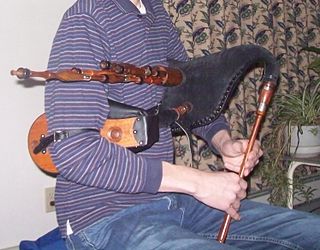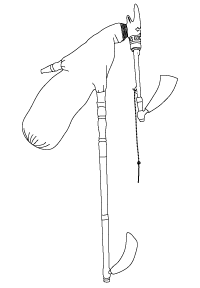Related Research Articles

Bagpipes are a woodwind instrument using enclosed reeds fed from a constant reservoir of air in the form of a bag. The Great Highland bagpipes are well known, but people have played bagpipes for centuries throughout large parts of Europe, Northern Africa, Western Asia, around the Persian Gulf and northern parts of South Asia.

The uilleann pipes are the characteristic national bagpipe of Ireland. Earlier known in English as "union pipes", their current name is a partial translation of the Irish language terms píobaí uilleann, from their method of inflation. There is no historical record of the name or use of the term uilleann pipes before the 20th century. It was an invention of Grattan Flood and the name stuck. People mistook the term 'union' to refer to the 1800 Act of Union; this is incorrect as Breandán Breathnach points out that a poem published in 1796 uses the term 'union'.

The hurdy-gurdy is a string instrument that produces sound by a hand-crank-turned, rosined wheel rubbing against the strings. The wheel functions much like a violin bow, and single notes played on the instrument sound similar to those of a violin. Melodies are played on a keyboard that presses tangents—small wedges, typically made of wood or metal—against one or more of the strings to change their pitch. Like most other acoustic stringed instruments, it has a sound board and hollow cavity to make the vibration of the strings audible.

The chanter is the part of the bagpipe upon which the player creates the melody. It consists of a number of finger-holes, and in its simpler forms looks similar to a recorder. On more elaborate bagpipes, such as the Northumbrian bagpipes or the Uilleann pipes, it also may have a number of keys, to increase the instrument's range and/or the number of keys it can play in. Like the rest of the bagpipe, they are often decorated with a variety of substances, including metal (silver/nickel/gold/brass), bone, ivory, or plastic mountings.

The great Highland bagpipe is a type of bagpipe native to Scotland, and the Scottish analogue to the great Irish warpipes. It has acquired widespread recognition through its usage in the British military and in pipe bands throughout the world.

The Scottish smallpipe is a bellows-blown bagpipe re-developed by Colin Ross and many others, adapted from an earlier design of the instrument. There are surviving bellows-blown examples of similar historical instruments as well as the mouth-blown Montgomery smallpipes, dated 1757, which are held in the National Museum of Scotland. Some instruments are being built as direct copies of historical examples, but few modern instruments are directly modelled on older examples; the modern instrument is typically larger and lower-pitched. The innovations leading to the modern instrument, in particular the design of the reeds, were largely taken from the Northumbrian smallpipes.

The border pipes are a type of bagpipe related to the Scottish Great Highland Bagpipe. It is perhaps confusable with the Scottish smallpipe, although it is a quite different and much older instrument. Although most modern Border pipes are closely modelled on similar historic instruments, the modern Scottish smallpipes are a modern reinvention, inspired by historic instruments but largely based on Northumbrian smallpipes in their construction.

The Galician gaita is the traditional instrument of Galicia and northern Portugal.
Northwest Iberian folk music is a traditional highly distinctive folk style, located along Spain's north-west Atlantic coast, mostly Galicia and Asturias, that has some similarities with the neighbouring area of Cantabria. The music is characterized by the use of bagpipes.

As Europe experienced a wave of roots revivals in the 1950s and 1960s, France found its regional culture reviving traditional music. Brittany, Limousin, Gascony, Corsica and Auvergne were among the regions that experienced a notable resurgence in the popularity of folk music. Traditional styles of music had survived most in remote areas, such as the island of Corsica and mountainous Auvergne, as well as the more nationalist lands of the Basques and Bretons.

The Hungarian duda is the traditional bagpipe of Hungary. It is an example of a group of bagpipes called Medio-Carparthian bagpipes.

The bladder pipe is a medieval simplified bagpipe, consisting of an insufflation tube, a bladder (bag) and a chanter, sounded by a double reed, which is fitted into a reed seat at the top of the chanter. The reed, inside the inflated bladder, is sounded continuously, and cannot be tongued. Some bladder pipes were made with a single drone pipe, and reproductions are similar to a loud, continuous crumhorn. The chanter has an outside tenon, at the top, near the reed, which fits into a socket or stock, which is then tied into the bladder.

The musette de cour or baroque musette is a musical instrument of the bagpipe family. Visually, the musette is characterised by the short, cylindrical shuttle-drone and the two chalumeaux. Both the chanters and the drones have a cylindrical bore and use a double reed, giving a quiet tone similar to the oboe. The instrument is blown by a bellows.

Welsh bagpipes The names in Welsh refer specifically to a bagpipe. A related instrument is one type of bagpipe chanter, which when played without the bag and drone is called a pibgorn (English:hornpipe). The generic term pibau (pipes) which covers all woodwind instruments is also used. They have been played, documented, represented and described in Wales since the fourteenth century. A piper in Welsh is called a pibydd or a pibgodwr.

The torupill is a traditional bagpipe from Estonia.

Blowzabella is an English folk band formed in London in 1978. The band currently consists of Andy Cutting, Jo Freya, Paul James, David Shepherd, Barn Stradling, and Jon Swayne; members of the band have changed multiple times since their inception, with Jon Swayne being the only remaining original band member. It is estimated that Blowzabella musicians played between 26 and 32 instruments in total, which include bagpipes, hurdy-gurdy, diatonic button accordion, alto sax, and triangle. Their music is heavily influenced by English and European traditional folk music, and has inspired a variety of European folk bands with their unique style and sound. Many European folk artists attribute Blowzabella as a major influence in their music.

Doedelzak is the name for bagpipes in the Netherlands and the Flemish (Dutch) speaking northern part of Belgium. This is the region where painter Pieter Bruegel the Elder lived and worked. Formerly pijpzak and moezelzak were common. The latter two names, generic at one time, survive in the piposa from Picardy and muchosa in the actual Belgian province of Hainaut. According to certain sources, muse once was the earliest generic name for this family of instruments in a large part of Europe and survives itself in the actual French generic name of cornemuse for all bagpipes.

The muchosa is a type of bagpipe dating back to the late 13th century in Hainaut, Belgium and northern France, where it is known as the pipasso.

Irish warpipes are an Irish analogue of the Scottish Great Highland Bagpipe. "Warpipes" is originally an English term. The first use of the Gaelic term in Ireland was recorded in a poem by Seán Ó Neachtain, in which the bagpipes are referred to as píb mhór.